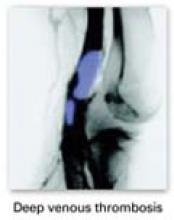User login
<court>Roanoke (Va) City Circuit Court</court>
After a 41-year-old woman underwent a hysterectomy, her physician prescribed conjugated estrogens, despite the woman’s history of deep venous thrombosis and the “black box warning” against use of conjugated estrogens in such individuals.
Shortly thereafter, deep venous thrombosis developed, leading to permanent partial loss of use of the left leg.
In suing, the woman asserted the physician should not have prescribed the medication when it was contraindicated.
The physician maintained the woman had not had an episode of deep venous thrombosis in more than 20 years, and that the medication was indicated because more than 90% of women who undergo oophorectomy require hormone treatment. The defense added that the woman had no evidence of permanent injury.
- The case settled for $500,000.
The cases in this column are selected by the editors of OBG Management from Medical Malpractice Verdicts, Settlements & Experts, with permission of the editor, Lewis Laska, of Nashville, Tenn (www.verdictslaska.com). The available information about the cases presented here is sometimes incomplete; thus, pertinent details of a given situation may be unavailable. Moreover, the cases may or may not have merit. Nevertheless, these cases represent the types of clinical situations that typically result in litigation and are meant to illustrate nationwide variation in jury verdicts and awards.
<court>Roanoke (Va) City Circuit Court</court>
After a 41-year-old woman underwent a hysterectomy, her physician prescribed conjugated estrogens, despite the woman’s history of deep venous thrombosis and the “black box warning” against use of conjugated estrogens in such individuals.
Shortly thereafter, deep venous thrombosis developed, leading to permanent partial loss of use of the left leg.
In suing, the woman asserted the physician should not have prescribed the medication when it was contraindicated.
The physician maintained the woman had not had an episode of deep venous thrombosis in more than 20 years, and that the medication was indicated because more than 90% of women who undergo oophorectomy require hormone treatment. The defense added that the woman had no evidence of permanent injury.
- The case settled for $500,000.
The cases in this column are selected by the editors of OBG Management from Medical Malpractice Verdicts, Settlements & Experts, with permission of the editor, Lewis Laska, of Nashville, Tenn (www.verdictslaska.com). The available information about the cases presented here is sometimes incomplete; thus, pertinent details of a given situation may be unavailable. Moreover, the cases may or may not have merit. Nevertheless, these cases represent the types of clinical situations that typically result in litigation and are meant to illustrate nationwide variation in jury verdicts and awards.
<court>Roanoke (Va) City Circuit Court</court>
After a 41-year-old woman underwent a hysterectomy, her physician prescribed conjugated estrogens, despite the woman’s history of deep venous thrombosis and the “black box warning” against use of conjugated estrogens in such individuals.
Shortly thereafter, deep venous thrombosis developed, leading to permanent partial loss of use of the left leg.
In suing, the woman asserted the physician should not have prescribed the medication when it was contraindicated.
The physician maintained the woman had not had an episode of deep venous thrombosis in more than 20 years, and that the medication was indicated because more than 90% of women who undergo oophorectomy require hormone treatment. The defense added that the woman had no evidence of permanent injury.
- The case settled for $500,000.
The cases in this column are selected by the editors of OBG Management from Medical Malpractice Verdicts, Settlements & Experts, with permission of the editor, Lewis Laska, of Nashville, Tenn (www.verdictslaska.com). The available information about the cases presented here is sometimes incomplete; thus, pertinent details of a given situation may be unavailable. Moreover, the cases may or may not have merit. Nevertheless, these cases represent the types of clinical situations that typically result in litigation and are meant to illustrate nationwide variation in jury verdicts and awards.
